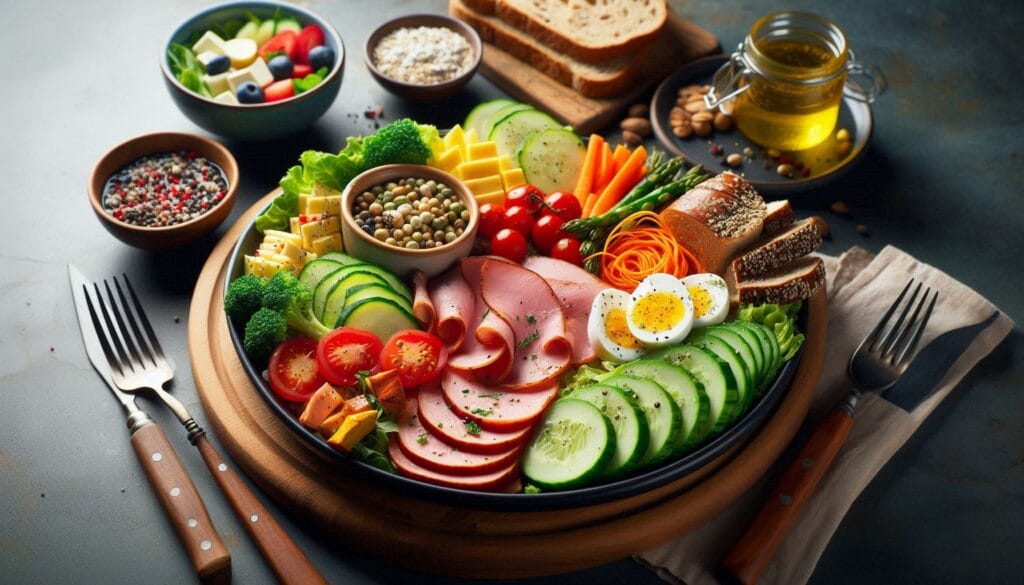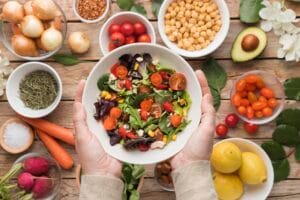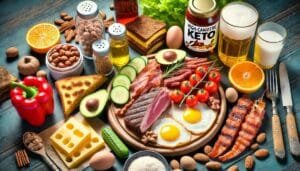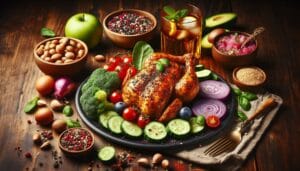The Ultimate Guide to the Best Vegetables for Weight Loss
- Published -
- Reading Time: 10 minutes
-
Written by - Chiranjeev Jaiswal
- Reviewed by - Dr. Josh Johnson

Vegetables have always been a critical ignored factor when it comes to weight loss. Many people focus on snacking less, portion control, and even calorie counting. In case you didn’t know, vegetables are a rich source of antioxidants, vitamins, and minerals that help aid in weight loss as well as overall health. In case you are looking to shed some pounds, the diet you stick to can help you tremendously.
This guide will focus on the vegetables which best aid with weight loss and additionally discuss their nutritional value as well as how they should be incorporated into daily meals for maximum impact.
What Makes Vegetables So Powerful In Weight Loss
Knowing the best vegetables isn’t enough without knowing why vegetables are an important component of a weight loss plan. Here is why vegetables must be part of your staples:
Low in Calories: Most vegetables have little to no calories, making them a great option for people trying to cut back on their calorie intake. This provides the opportunity to eat larger portions without consuming too many calories and reduce weight.
Great for Digestion: Vegetables are a rich source of dietary fibers that increases the feeling of satiety. First, fiber takes a long time to digest, which causes a decline in appetite and wards off overindulgence. Vegetables also foster digestion which is important in the process of losing weight.
A Treasure of Valuable Compounds: Most vegetables are nutrient dense, providing a wealth of vitamins and extra manganese with minimum calories; that is, at times losing calories. This is crucial to avoid starvation when people are trying to shed extra weight.
Water Retaining: A lot of vegetables have higher water quantity and as a result help in keeping you fresh while supporting the losing weight along with it. Added water is always useful in speeding metabolism and other body activities which somewhere aid in weight loss.
Helps in Burning Fat: A few types of vegetables have some substances that will increase metabolism, reduce inflammation and help burn fats, making themto be evenmore helpful during your weight loss regimen.
How are vegetables used to aid the process of weight loss?
Vegetables helps in weight loss not only from thier nutrients but rather through selective bioactive compounds with the ability to alter the specifics in the body.
- Fiber and Satiety
One way to help people feel full is by consuming fiber foods as they expand in the stomach and absorbs water. Fiber can slow digestion and prevent overeating. Fiber has also been shown to increase the secretion of hormones like ghrelin, (which stimulates hunger) and leptin (which signals fullness). When you eat fiber rich vegetables, you naturally suppress ghrelin level and enhance leptin’s effects, thus leading to reduced appetite and fewer calories consumed.
- Boosting metabolism
Cruciferous vegetables, including broccoli, cauliflower, and kale, contain sulfur and indole-3-carbinol that have been shown to boost one’s metabolism. These compounds activate enzymes in the liver that increase the body’s ability to detoxify and helps the body break down fat. Sulfur has been found to speed up the rate of fat metabolism in the body and should be added as part of vegetables diet for better metabolic health.
- Reducing Antioxidants and inflammation:
Chronic inflammation is one of the few factors that tend to lower the rate of weight loss while contributes to fat storage. Some of those include vegetables like bell peppers, cabbage, and Swalot are rich in Vitamin C and other herbal flavonoids that are potent in antioxidant which helps reduce inflammation. A decrease in inflammation causes the body to function efficiently which include burning fat more effectively.
4: Water and Detoxification:
Vegetables like cucumbers, celery, and zucchini have a good deal of water. They assist in detoxification by facilitating the expulsion of waste via the kidneys and urinary system. Water keeps you hydrated, which is good for your metabolism as it assists in fat burning and losing weight.
5: Impact on Relevant Hormones Affecting Appetite:
Some vegetables have compounds that affect the appetite hormones responsible for hunger and satiation. To name an example, asparagus has the amino acid asparagine, that is thought to help in controlling the hormone that helps reduce appetite. Another is Magnesium containing spinach, which helps to control craving a bit, level blood sugar and indirectly aid in weight loss.
Best Vegetables for Weight Loss
- Spinach
Spinach is low in calories but nutrient-loaded leafy green such as Vitamins A, C, K plus folate, Iron and magnesium and it’s sooooo rich and beneficial. It packs a lot of goodness while being low in calories. It is also rich of fiber which aids in digestion and keeps you fuller for longer.
• Benefits for Weight Loss: Spinach is extremely nutritious and can be consumed in a variety of ways, including salads, smoothies, omelets, and soups. It fibers too contributes to fast fuller feeling and less inappropriate eating tendancy.
• How To Incorporate: Fit in spinach with smoothies for a nutritious boost or add it as a base for a healthy salad. You can also sauté it with garlic and olive oil for a delicious side. For an even more delcious side dish, sauté with olive oil and garlic.
- Broccoli : This cruciferous vegetable has a myriad of vitamins, minerals, and fibers. The sulfur compound contained in broccoli, sulforaphane, is proven to aid weight loss because of its ability to increase metabolism and burn fat.
• Benefits for Weight Loss: Broccoli is an excellent option as it is low calorie and high in fiber. Additionally, broccoli’s full fiber diet also helps digestion and lower bloating.
• How to Incorporate: Broccoli can be steamed, roasted, or even eaten raw in salads. It goes well with so many meals, giving you no reason not to make it. Add it to stir fry or use it in casseroles, too.
- Cauliflower This is yet another cruciferous vegetable providing you tons of nutrition while keeping calories low. It has a ton of fiber, antioxidants, and vitamin C.
• Weight Loss Benefits: Because of its low carbohydrate content, cauliflower can be a great alternative to grains and starchy vegetables which makes it ideal for people following a keto or low-carb diet plan. Cauliflower also has a high fiber and water content which makes it easier for one to feel full throughout the day.
• How to Incorporate: Cauliflower can be roasted, steamed or even used instead of rice or as mashed potatoes. You can even create soups and stews with cauliflower or make pizza with a cauliflower crust.
- Zucchini
Another weight-loss friendly food is zucchini. A vegetable that contains very few calories and high water content alongside aiding nutrients like vitamins A and C, potassium, folate and many more.
• Weight Loss Benefits: Because of the high water content, Zucchini is a low calorie food which also makes it perfect for people trying to shed some weight. It’s high in fiber which is good for digestion too as it keeps you full for a long time.
• How to incorporate: Zucchini can be grilled, sautéed, or added to stir-fried. You can also use them in the form of noodles replacing the pasta, which can decrease calorie consumption tremendously.
- Kale
Another popular leafy green superfood is Kale due to its high nutrients value. It is rich in Vitamins A, C, and K and is also a great source of calcium, potassium, and antioxidants.
• Benefits for Weight Loss: Kale is a low-calorie vegetable that is also high in fiber and is very helpful in losing weight. The fiber helps keep you full, aids in digesting and in addition, some studies have shown that Kale may have properties that lowers inflammation which improves metabolism.
• How to Incorporate: Kale can be added in smoothies or salads, or make it quick by putting it in soupl or quickly cooking it with olive oil and garlic. It can also be added in some pasta for a healthy side option.
- Cucumbers
Cucumbers are extremely hydrating since they have approximately 95% water. They also have low calorie count and are a good source of vitamin k and antioxidants.
• Benefits for Weight Loss: Cucumbers are beneficial since their high water content helps with hydration, lowers bloating, and gives a feeling of satiety. They can be incorporated in your diet as a healthy snack and for people tryng to lose weight.
• How to Incorporate: Cucumbers can either be added to salads, sliced and eaten as a healthy snack, or even blended in smoothies. You can also pickle them and make a tangy, low-calorie snack.
- Bell Peppers
Red, yellow, or orange bell peppers are particularly rich in vitamin C and contain various antioxidants. Additionally, these are low in calories and rich in fiber.
• Benefits for Weight Loss: The fiber in bell peppers makes them very good for digestion and feeling full. Because of this, they are good for a weight loss diet. These can also be served as a snack or added to several dishes.
• How to Incorporate: Bell peppers can be consumed raw by adding them to salads, added to stir-fries, or stuffed with nutritious ingredients like quinoa or lean meats.
- Asparagus
Asparagus is also a high-fiber and low-calorie vegetable that is very rich in vitamins A, C, K, and is very high in folate and other antioxidants. This vegetable has some special nutrients like inulin, which is a kind of prebiotic fiber very beneficial for gut health.
• Benefits for Weight Loss: Asparagus is also known for helping digestion and reducing bloating. It is also a natural diuretic, decreasing excess water weight.
How to Incorporate: Asparagus can be served steamed or roasted, or even grilled. It goes well with multiple proteins like chicken or fish, and is a perfect compliment for salads and stir fries.
- Carrots
Rich in beta-carotene, root carrots are a well known vegetable. In addition, it is a good source of fiber, potassium, and antioxidants.
How to Incorporate: Carrots can make a great snack when enjoyed raw, and are a good addition for soups, stews, and salads. You can even roast them for an aromatic, savory side.
Benefits for Weight Loss: Packed in nutrients with lots of fiber and low in calories, carrots make for a grin satisfying snack. They are good for general wellbeing due to high antioxidant properties.
- Green Beans
Provide more than just good taste, green beans are cardio friendly because of its vitamins. In addition beans also contain vitemans and minerals such as A, C, and K, and folate with fibers.
Benefits for Weight Loss: Like carrots, green beans are low in calories and high in fiber. This makes beans useful for enhancing digestion and giving a feeling of fullness. Plus, high water content helps with skin and body hydration.
Green beans can be steamed, sautéed, added to casseroles, or even stirred into a stir-fry, and salads can always use some extra beans here and there.
Weight Loss Tips for Including Vegetables In Your Diet
In order to loose weight, these are the practical tips needed to help you incorporate the best vegetables into your diet.
Mix it All Up: Incorporating a variety of vegetables as a whole will ensure you get all the nutritional benefits that come with it. So incorporating different kinds of vegetables with different colors will broaden the range of vitamins and minerals as well as antioxidants you receive.
Meal Prep: One way to easily add vegetables into your meals is to chop, wash and store them in the fridge ahead of time.
Get Creative with Your Meals: Instead of higher caloyrie substitutes for foods, try to inclusiónmore vegetables, for instance, Instead of pasta use zucchini noodles, cauliflower makes exceptional rice, and roasted sweet potatoes are much tastier than fries.
Include Vegetables in All Meals: Make sure to include vegetables in every meal, be it in a salad, stir fry, soup, or even as a side. This helps in meeting fiber requirements and essential nutrients without exceeding calorie targets.
Blend Veggies into Smoothies: Adding vegetables such as leafy green spinach, kale, or even cucumbers into smoothies is an effective way of boosting vegetable consumption without feeling the pinch.
Specific Suggestions for Any Diet
There is no ‘one size fits all’ approach when it comes to diet. Now, let us see how to add these vegetables while taking into consideration different dietary preferences:
Vegan/Vegetarian: Some vegan friendly vegetables which can be used for plant-based diets include broccoli, kale, spinach and cauliflower as they are rich in protein and fiber. These can serve as the core of a nutrition dense vegan friendly weight loss diet.
Low Sodium Diet: Most vegetables naturally have low sodium levels. For people on low sodium diets, these vegetables are great. Zucchini, spinach, and kale are also good vegetables that will not add unwanted sodium into your diet.
Low-Carb/Keto Diet: Spinach, Zucchini, Broccoli, and Cauliflower are low in carbs, high in fiber, and nutritious; therefore, they are great foods for people on keto or a low-carb diet. These vegetables can work as substitutes for grains and high-carb pasta.
The Common Questions Reagrding the Eating of the Vegetables
Although the vegetables are important in any balanced diet, there are some populations who may not consume them due to different challenges. Below are two universal challenges and their solutions:
Liking the food: If you dislike some types of vegetables, s try putting them in a food with stronger tastes, like stir fries or soups. Also, try other cooking methods like grilling or roasting because they may taste much better.
Cooking Time: People hate preparing vegetables because it is a waste of time. Try doing things like washing and cutting vegetables beforehand and storing them in the fridge. Frozen or prepackaged vegetables are good options too.
Cooking Techniques: Raw vegetables are always good, but it is a common misconception that consuming them unprocessed is the best option. For example, carrots have beta-carotene which is good for the health and its absorption is improved when it is cooked. Other methods like steaming, roasting, and grilling are some amazing ways of cooking that vegetables while ensuring that the nutrients are still trapped.
Conclusion
Adopting a diet that includes vegetables is one of the best methods to aid in weight loss while also supporting a well-rounded diet. Vegetables tend to be low in calories and high in fiber which aids in satiety, digestion, and metabolism. With the further inclusion of certain vegetables, one can achieve their weight loss goals and also keep the body satiated.
Do not forget that consistency and persistence define successful weight loss; hence, make an effort to incorporate vegetables into your daily meals and have fun trying to cook them in new ways.
FAQs
- Which vegetables are best for weight loss?
- Some of the better vegetables for losing weight include spinach, broccoli spinach, cauliflower, zucchini, kale, bell peppers, cucumbers, and asparagus. They are low in calorific value and have high fiber content.
- How do fiber and water in vegetables assist in weight loss?
- Vegetables are known to be a good source of water, and its consumption helps deal with issues relating to dehyderation. Fiber found in vegetables also promotes hydration and reduces carbohydrate consumption, all this while supporting proper digestion and metabolic processes.
- Can a lot of vegetables promote weight loss?
- Peoples’ perceptions that vegetables require minimal calorific intake have contributed to the surge in their intake. While this might be popular, whirlwind marketing is not the entire truth. Alternatively, one can derive a heap of calories through highly calorific dressings, oils, and other ingredients. Because of this, there is a need for moderation across the board. If we focus on stuffing our food ration with veggies, we risk being overweight too.
- Are cooked vegetables less effective for weight loss than raw vegetables?
- Both types of veggies are key to successful weight loss and diet management. They are consumed both raw and cooked. In fact, peppers contain beta-carotene which when cooked or steamed, allows better transference of nutrients. Being overzealous with the oils and fats during preparation should be avoided.
- Can I eat vegetables on low carb or keto diet?
- Vegetables low in carbs and high in fiber, such as spinach, zucchini, broccoli and cauliflowers, are ideal for people on a keto diet. So yes, people on a low carb diet can eat these vegities with peace of mind.
- What is the relationship between vegetables and hunger hormones?
- Certain vegetation contains certain compounds that influence hunger hormones such as ghrelin and leptin. Fiber abundant vegetables, in particular, affect these hormones and minimize appetite.
- How much does a person have to stalk vegetables to lose weight?
- Potato and corn are classified as starchy vegetables classified which are significantly higher in calories and carbs than their non-starchy counterparts. Their consumption should be curbed to assist with weight loss.
- In what quantity should vegetables be taken for weight loss?
- For every meal, a person should try to consume more than half a plate of non-starchy vegetables. For enhanced weight loss, a person needs to eat a minimum of three to five serving of vegetables in a single day.
- Do vegetables assist with inflammation in regards to weight loss?
- Absolutely, Leafy greene along with bell pepper and tomatoes have astounding anti inflammatory properties which help reduce inflammation and enhance metabolic function, all of which assist in weight loss.
- What is the ideal way to maximize the preparation of vegetables for weight loss?
- To enhance the health benefits, try steaming or roasting the vegetables while using the bare minimum oil and seasoning. Do not deep fry or over roast them as it reduces their nutrient value.






